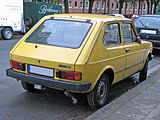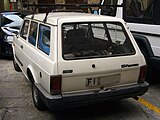Fiat 127
| Fiat | |
|---|---|
|
Fiat 127 (1971-1977)
|
|
| 127 | |
| Production period: | 1971-1987 |
| Class : | Small car |
| Body versions : | Sedan , hatchback , station wagon |
| Engines: |
Otto engine : 0.9–1.3 l (29–55 kW) Diesel engine : 1.3 l (33 kW) |
| Length: | 3595 mm |
| Width: | 1525 mm |
| Height: | 1360 mm |
| Wheelbase : | 2225 mm |
| Empty weight : | 705-710 kg |
| Previous model | Fiat 850 |
| successor | Fiat Uno |
The Fiat 127 is a small car from the Italian vehicle manufacturer Fiat , which was produced from spring 1971 to early 1987 (most recently in Argentina until 1997). The design comes from Pio Manzù.
Model history
At the end of March 1971, Fiat launched the modern 127, a hatchback sedan with a separate trunk, as the successor to the Fiat 850 with transverse engine and front-wheel drive . A year after the start of production, after the Renault 5 came on the market, a variant with a tailgate was offered. The 127 was voted " Car of the Year 1972" and achieved high sales figures. The four or five-door Fiat 127 also offered in Germany came from the Spanish SEAT production line
The engine with 903 cm³ displacement and an output of 34.5 kW (47 hp) at 6200 rpm came from the 850 Sport series. It drove the front wheels via a fully synchronized four-speed gearbox with stick shift. The gearbox was locked to the differential and the drive shafts were unequal in length. In Germany, the power of the engine was specified as 33 kW (45 PS) in order to be able to classify the model in a cheaper insurance class. The 127 had a self-supporting body, the front wheels were individually suspended on MacPherson struts and wishbones, and the rear suspension on shock absorber struts , trapezoidal wishbones and a transverse leaf spring, which was common in Fiat's front-wheel drive models at the time. 1973 followed the 127 Special with extended equipment.
Facelift
In the fall of 1977, the 127 is a comprehensive received facelift , driven by the recent 45-horsepower engine it in Germany and in a regular gasoline version with 29 kW (40 hp) with facelift, revised interior and a model staggering in L, C and CL or, in the case of the CL, a new, 37 kW (50 hp) 1049 cc four-cylinder engine. All versions now had a large tailgate, the basic model 900 L was initially also available as a two-door. In addition, the Fiorino van version with a higher roof was added to the range.
At the beginning of 1978 the 127 Sport with 51 kW (70 PS) strong register carburetor version of the 1049 cm³ engine appeared (double carburetors were only available in the upgraded special model of the tuner Hörmann). From 1980 the range of models was divided into the versions Special, Super and Sport. Changes to the engine with five-bearing crankshaft and an overhead camshaft driven by a toothed belt affected a new light-alloy cylinder head with larger intake and exhaust valves, camshaft profile with longer opening times and an increase in compression from 9.3 to 9.8: 1. The 127 had an Abarth exhaust system with a double tailpipe. Further measures included strengthening the front stabilizer from 19 to 21 mm, the final drive ratio was shortened slightly and front brake calipers of type 128 were installed. Externally, the 127 Sport could be recognized by the black radiator grille. The performance should have been 160 km / h and the acceleration 0-100 km / h in 14 seconds.
From 1981 diesel and station wagon versions of the local Fiat 147 supplied from Brazil were sold in Italy under the designation 127 D and 127 Panorama.
At the beginning of 1982 the 127 was given another facelift. At the same time, the 127 Sport received a 1301 cm³ engine with 55 kW (75 PS).
After the introduction of the successor Uno in March 1983, a single version of the 127 remained on offer in some European markets, as a sedan with the Super equipment, until the beginning of 1987. A total of around 4.5 million of the 127 were sold.
In 2005, around 300 copies of the 127 were officially registered in Germany, this number referring to the years of construction from 1971 to 1987.
The Fiat 127 all over the world
The license model Seat 127 was manufactured in Spain and developed into a five-door model there. The five-door cars were sold outside of Spain as Fiat 127. After the takeover of Seat by Volkswagen, the model name was changed to Seat Fura . With different brand emblems, but otherwise unchanged, it was manufactured and sold by the Polish vehicle manufacturer FSO until 1987 as Polski Fiat 127p in Poland for the Polish domestic market.
From autumn 1976 the Fiat 127 with modified front and rear sections and the 1049 cm³ engine was manufactured as Fiat 147 in Brazil .
At the beginning of 1978 a delivery van with a box body, similar to the later Fiat Fiorino, called the 127 Moretti Midimaxi, followed . In order to be able to keep up with the corresponding versions of the Chevrolet Chevette , Fiat Brazil (also in 1978) also brought out the 127 Rallye with a 45 kW (61 hp) 1.3-liter four-cylinder engine. In 1979, the 127 with a new 1.3-liter alcohol engine 44 kW (60 hp) was one of the first cars of the post-war period that could be run on pure alcohol.
In 1980 the 147 received a facelift and was available in the versions L, GL, GLS and Rallye (1050 cm³ or 1.3-liter for petrol or alcohol or 1.3-liter diesel engine). At the same time a combination version called Panorama appeared.
In 1983, the better equipped Spazio variant with a revised front section was added to the range, along with the Oggi , a two-door notchback version . The Fiat Uno, introduced in Brazil in August 1984, gradually replaced the 147 variants. In 1986 the production of the last versions ended after a total of 1,169,312 copies.
In Argentina , Sevel Argentina began manufacturing its own versions based on the Brazilian Fiat 147 in 1981 , which was not ended until 1995. Hatchback sedans were produced under the names Fiat 147, 147 TR, 147 Sarpasso IAVA (a sports version with 66 kW (90 PS) 1.3 liter engine), Brío , Spazio and Vivace , usually powered by the 1049 cm³ Engine, a petrol version of the 1.3-liter engine or the 1.3-liter diesel. A total of 232,807 units of these models were built in Argentina.
In 1977 the Fiat Fiorino van was derived from the Fiat 127 with the front section of the 127 and a box body at the rear.
In Yugoslavia , the Yugo was developed on the platform of the 127 , which became a cult car in the USA in the late 1980s.
In Greece , Autokinitoviomihania Ellados manufactured the Fiat Amico 127 , an open multi-purpose vehicle, based on the Fiat 127 .
The 127 was also assembled at Livingstone Motor Assemblers in Zambia.
literature
- Joachim Kuch, Wolfgang Schmarbeck: Fiat - passenger cars since 1945 . 1st edition, Motorbuch-Verlag 1998, ISBN 3-613-01906-X ( type compass - compact and competent )
Web links
Individual evidence
- ↑ New vehicles from Fiat . In: ATZ Automobiltechnische Zeitschrift . 1978th edition. No. 9 . Franckh'sche Verlagshandlung, Stuttgart, p. 414 .
- ↑ O pequeno notável. Best Cars Web Site (Brazilian website on the history of the Fiat 147, Portuguese).
- ↑ SEVEL ARGENTINA SA Coche Argentino (website for the Fiat 147 in Argentina, Spanish).












